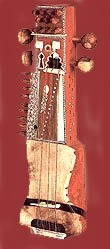
About the Instrument - Sarangi
An instrument whose versatility cannot be doubted. The name itself reflects this, and is believed to be a derivative of Sarang (Sanskrit for 'spotted deer') or Saurangi (Hindi for 'of a hundred colours'). The antiquity of the sarangi cannot be questioned either, for the instrument finds mention in both the
Ain-i-Akbari and the Sangita RatnakaraStructurally, the sarangi is a small instrument, no more than two and a quarter feet high. Carved out of a singel piece of wood, it has a hollow body, with a one-inch thickness at the upper and lower surfaces, and less than half-an-inch thickness at the sides. The instrument is strengthened by a bar across its height. There is a parchment-covered belly usually with holes and 'waist'. This shaping is more marked on the left side. The three main playing strings (made of gut) and one brass sympathetic string are tuned by the four pegs in the lower part of the peg-box on the side. The upper part of the peg-box has eleven tuning pegs for the other sympathetic strings which may be from thirty-five to forty in number. The sarangi is conspicuous by the absence of frets.
The strings are suspended by four bone bridges: one bridge carries the playing and the sympathetic strings through different notches, the second bridge raises the main playing strings approximately half-an-inch above the instrument; two bridges carry five or six sympathetic strings each. These bridges resemble the sitar bridge and, similarly, serve to enhance the tone.
The bow (made of horsehair) is held in the right hand while the left hand is used to stop the strings. A distinctive style emerges through the 'fingering' technique: the strings are stopped by bending the finger and working with the nail next to the cuticle. The third finger is used most often while playing, the middle and index fingers next. On a rare occasion is the little finger used.
Interestingly enough, the music produced by the sarong, more than that of any other instrument, is believed to resemble the human voice. It is thus the ideal instrument for musical accompaniment, and allows the singer to pause without causing a break in the singing. It can be played simultaneously with the singing, it can fill in gaps, or 'shadow' the song by being played just a little behind it.
The magic of the sarangi is its bane as well! Since it easily imitates the human voice, it can prove a distraction for the singer. Besides, the large number of sympathetic strings that create the special sounds demand a lengthy time-period for tuning. The sarangi requires mastery (of playing and tuning) and maturity (in understanding the raga & not intruding on the vocalist). It is due to the skill of the sarangiyas that the sarangi has come into its own as a solo instrument.
